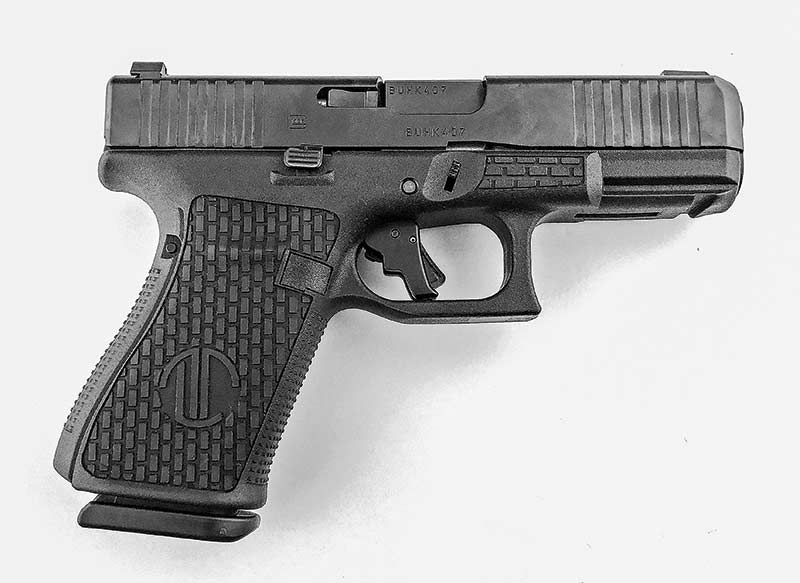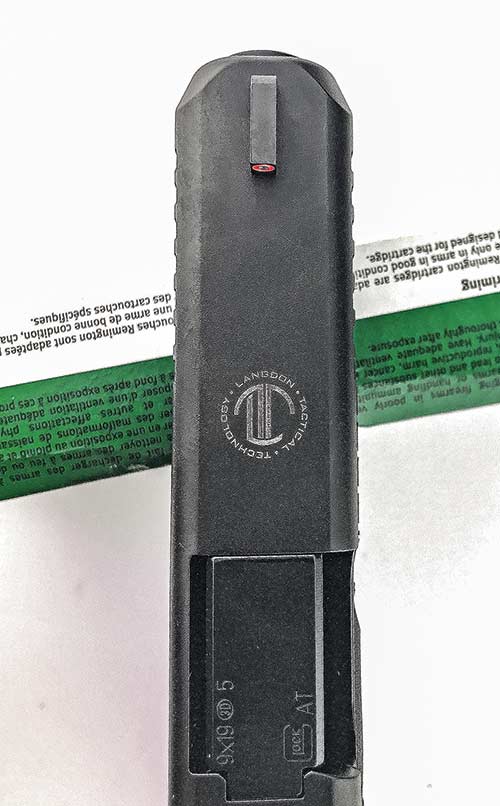Langdon GLOCK
From DA Guru to GLOCK Magician
For a while, it was something of a secret among the cognoscenti that world champion Ernest Langdon, who shot and gunsmithed his way to fame with the DA Beretta 92, had started carrying a GLOCK 19. There was method to his madness: He was testing his interpretation of this uber-popular modern classic to be offered by his company, Langdon Tactical Technologies.
Mods With Meaning
Out of the box, the first thing you notice different on this Gen5 GLOCK 19 with fore and aft grasping grooves on the slide, is the stippling. It covers the side grip panels (supplementing regular GLOCK stippling on the front- and back-straps), and also along the dust cover. This latter feature gives the trigger finger a palpable safe “register” point for ready position on one side, and on the other side, a spot to index the support hand thumb in the straight-thumbs firing grasp.
The fixed sights on our sample are Ameri-Glo, a configuration I like so much I have them on three of my own GLOCKs. The front post has a big orange ball for fast acquisition in daylight, with a bright Tritium ball in the very center for night shooting. All this aligns with matching green Tritium inserts flanking the generously sized square rear notch.
On our test sample, that stippling takes the form of a unique “brick” pattern. Explains Langdon, “After stippling a bunch of guns, the brick pattern gave the best control and feel while being easy to clean if it gets messy. I get the best control from that pattern over others we tried. The direction of the pattern is specific as well. We run the brick lengthwise to help control the rotation of the gun in your hand.”
Coming next to the eye were a couple of other custom features. One was the already-installed C&T SpeedFeed magazine well. Another was an undercut at the bottom rear of the trigger guard where it meets the frame. There are other custom makers who do this, but they don’t all round the remaining edges. LTT does, and it makes a positive difference, as we’re about to see.
From the serious shooter’s side, the trigger is the heart of an LTT GLOCK. It’s from Apex, which has earned a sterling reputation. It’s flat-faced, which is currently popular, and more to the point it has “the Langdon touch.”
Ernest told us, “The trigger work is mainly polishing. One thing we are good at is polishing trigger parts. That is the key to our great Beretta Triggers and what we have taken over to the GLOCKs. So we polish all the right places in the fire control and reassemble the gun with the APEX trigger installed. Our goal is a safe, reliable and shootable trigger. We did not try to make it super light, just smooth, consistent and predictable.”
Shooting The LTT GLOCK
That Langdon trigger won the hearts of all on the test team, including those who didn’t care for the flat-face configuration. As Ernest had promised, it was extremely smooth. On the Lyman digital scale, pull weight measured 6.11 lbs. at the center of the trigger, where the finger normally rests. At the toe of the trigger, leverage reduced pull weight to 5.06 lbs., a tad under the 5.5 lbs. GLOCK mandates for defense guns.
Being one of those people whose middle finger gets pounded at the median joint shooting some handguns, including but not limited to the GLOCK, I generally put a protective adhesive bandage there before shooting a qualification, match, or class with one. I didn’t have to do that with the Langdon GLOCK, which by the way gave me a perfect 300/300 on a qualification run whose 60 shots included one-hand-only with each hand. The gun shot straight to the sights with the 115-grain ammo I used, speaking of the care taken by those who put the pistol together. The C&T SpeedFeed mag well did indeed smooth and speed up our reloads.
Several hundred rounds of ball and JHP went through the test gun. As expected, function was 100% except for one new shooter who limp-wristed at the beginning, which can malfunction any auto pistol.
Accuracy
Encompassing the three most popular bullet weights for the caliber, our accuracy test-firing was done two-handed from a Caldwell Matrix rest on a concrete bench at 25 yards. Groups were measured twice, center to center between the farthest flung hits, first all five shots to get an indication of predictable accuracy in experienced hands and perfect conditions, and again for the best three. The best three tends to indicate what the gun might have done with all five from a machine rest assuming no called flyers. With every round, the first hand-cycled shot went to 11 o’clock and subsequent bullets went lower and more to the center. This syndrome applies to many semiautomatic firearms.
The 115-grain load was the one most readily available at that point in the “ammo drought,” CCI Blazer Brass 115-grain full metal jacket. All shots went a tad left of point of aim, all five of them in a 2.9″ group and the best three in 2.25″.
Our 147-grain subsonic load was Remington-UMC jacketed truncated cone training ammo. The 5-shot group measured a disappointing 4.35″, but faith was somewhat restored by a 1.20″ “best three” measurement. These too grouped a little left.
LTT G19.5 serial number BUHK407 hit its stride with a 124-grain SIG V-Crown jacketed hollow point. In the few years it has been out I’ve found this brand of ammo consistently accurate, and it lived up to expectations here with five shots in 2.4″, including the 11 o’clock first shot. The next four rounds formed a 1.25″ group, and the best three, a super match-accurate 0.85″. All but the first shot were dead center in the Birchwood Casey “Shoot-n-C” bulls-eye.
Summary
New shooters are obviously not the main target demographic of LTT guns, whether they’re Berettas or GLOCKs. It’s the experienced shooter who most appreciate the Langdon treatment. I own a couple of LTT Berettas, which have been very good to me in competition. What you’re paying for is improved performance and, let’s face it, a prestige factor. Just as a Ford Mustang with a Shelby badge on it isn’t “just a Mustang” anymore, a GLOCK with an LTT logo stamped on it isn’t “just a GLOCK” anymore.
A complete LTT GLOCK 19 Gen5 set up like our test pistol retails for $1,026 direct from LTT. Of course, it will cost you less to have your own GLOCK “Langdon-ized.” The guns are selling fast but wait time is still reasonably short.













